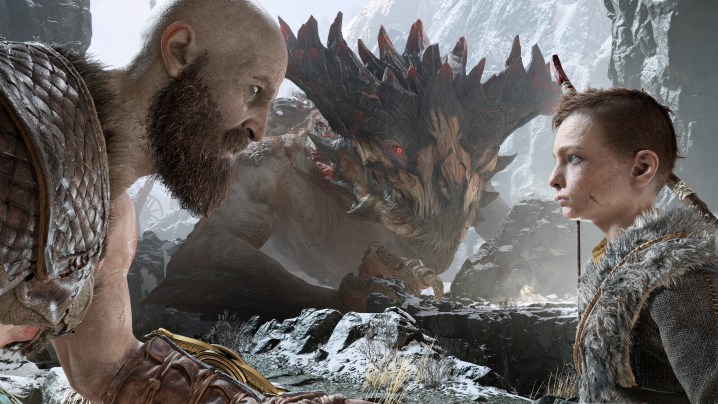
It’s been over five years since the Spartan roided-out rage avatar, Kratos, wielded his Blades of Chaos to do what he does best: murder an entire pantheon of gods. Although Kratos cleared out all of the local deities from his native Greece through the previous trilogy and assorted handheld titles, he’s now made his way up north to give the Norse gods what’s coming to them.
God of War is a stunning return-to-form for the classic action series, translating its mechanical and narrative essence into a new context, with new life. Accordingly, while fans of the series will feel right at home in Kratos’ boots, even the most seasoned veterans will have to get their bearings. Here are our starting tips for God of War.
Author’s Note: These tips are based on our experience playing on the default, “Balanced” setting. Higher difficulties will require you to dig deeper into the game’s systems in order to survive.
Kratos smash!

Even if it’s been ages since you’ve played a God of War game, you probably remember that Kratos is a bull in a china shop and loves to shatter anything that isn’t strapped down — pottery, crates, furniture, shoddy-looking plank walls, and so on. On top of the visceral satisfaction of breaking things for its own sake, it’s a good habit to smash everything as you go for the resources you might find. Nearly every cluster of debris will give you a little bit of hacksilver, which you can use to buy and craft new gear, or the occasional health crystal to keep you sustained during long fights. Five or ten coins here or there won’t sustain you, but it definitely adds up. Debris can also block bigger rewards — hidden passages or chests — so it’s always a good habit to just break everything you can.
Get a fresh perspective

As you’re breaking everything in the Nine Realms, be sure to keep your head on a swivel and be thorough in exploring every space. Look up, down, around corners, and check out rooms from every angle before you move on, because the level designers constantly use perspective in order to fill areas with more collectibles and hidden paths than are immediately obvious. Stone vessels containing hacksilver or items often hang above areas outside of your immediate field of vision, only to stare you right in the face when you loop back into the same room from a new entrance. You can save yourself a lot of backtracking once you start anticipating their tricks and exploring every room thoroughly the first time.
This is also helpful advice for solving many of the game’s puzzles that require you to hit targets in rapid sequence by throwing your Leviathan axe, such as to open rune-locked chests throughout the game. Many puzzles that felt just out of reach when we were running back and forth to brute-force them were easily solved by taking a minute to find a new position from which we could see all of the targets.
Patronize dwarves early and often

The dwarven blacksmith brothers Brokk and Sindri serve as merchants for the entire game, crafting and upgrading all of your gear as the game’s primary progression system. As dwarves the brothers have a supernatural gift for showing up just about everywhere you are, and eventually the game opens up such that you can freely travel anywhere, but for much of the early game you are locked into linear sequences where you won’t run into either brother for a while. Accordingly, make sure you take full advantage whenever you run into them early on: Buy and upgrade to the best available gear (especially keep your weapons upgraded, since this gates your skills), and unload collectibles so you won’t find yourself doing any tedious backtracking in order to gear up for a tough fight.
Gear level is everything
God of War adds more stats and loot than any previous entry in the series, which can be a little intimidating at first if you’re not coming from RPGs (or Madden). The different gear options at each tier allow you some choice in how you want to build Kratos. Each of the four armor categories — chest, wrist, waist, and talisman — comes in various forms that emphasize specific stats, and types of play. Focusing on Strength will give you more powerful attacks, Runic and Cooldown gear will enhance your special attacks. It’s hard to avoid being hit entirely, however, so we found that gear boosting Defense and Vitality were what carried the day. The Traveler’s set in particular, which you can start crafting about midway through, was our mainstay for a lot of the game until the best gear becomes available at the end.
Fortunately, at least at Balanced difficulty the only number that really matters is the overall “gear level” of the item, ranging from 1 to 8. The total of all Kratos’ equipment feeds into his overall level, which is the largest determining factor in how difficult enemies are. So far as we can tell it works similarly to Light levels in Destiny, where your net equipment level determines how tough enemies are (higher level enemies take very little damage and dish out quite a bit, while you can slice through lower level enemies with ease). No matter how you choose to spec your character, you should always prioritize raising your armor level, even if it means taking a small hit to a stat you might care about — the impact of going up one of eight levels is far, far greater than a fairly wide range of direct stat changes.
Don’t be a show-off

Progress is frequently quite linear in God of War, so there’s never really any question of where you’re supposed to go next. At several points, the game unveils a large number of new optional sidequests and activities, giving you the chance to explore for secrets and improve your loot. Enemy health bars are conveniently color-coded to help you immediately see where you stand in any given encounter. Green means they are below your level and shouldn’t cause any problem. Yellow means an even match, so you’re probably right on course and should be fine so long as you don’t get overwhelmed. From there on enemies progress to orange, red, and the deadliest purple foes, which can frequently one-shot you while absorbing a lot of punishment.
One or two red or purple enemies, even in concert with some weaker support, can be a manageable and dramatic fight. There’s absolutely no shame in leaving and saving an encounter for later, however. There’s no reward besides pride for defeating an enemy that totally outmatches you, so if you’re hitting your head against, for instance, a group of purple-healthed heavy Hel-spawn, just go do something else and come back with better gear. There are enough side quests and optional challenges around that you never need to really “grind” anything repetitive to stay potent against the vast majority of the game’s content.
Row your boat (for profit and knowledge!)

The game’s open sections center around the Lake of the Nine hub area, which opens up wider as the water lowers at several points throughout the story. As you row around, you’ll notice floating barrels, debris, and sparkly patches in the water. Run over these and Atreus will snatch resources out of the water like hacksilver or Aegir’s gold. These spawn randomly and forever, so if you’re ever totally broke and need to scrape together some change for a crucial upgrade, take a cruise around the lake, being sure to explore every nook and cranny for secret beaches. Fortunately the developers foresaw that you’d be spending a lot of time on the boat, so eventually the time gets filled by telling stories from Norse mythology, giving the world a ton of narrative context and flavor.
The cat’s in the cradle

Your son, Atreus, is probably the most significant addition to this new God of War. Going from a timid little boy at the beginning to a hardened killing-machine by the end, Atreus grows a lot over the course of the story. For your purposes in combat, however, what you ask of him remains relatively constant. Press square and Atreus will shoot an arrow at whomever you are targeting. This will do a little bit of damage (increasing as the game goes on) as well as interrupting attacks and filling up the enemy’s stun meter.
Those latter two effects are the most useful. Enemies that are about to attack Kratos will emit an off-white (or red, for unblockable attacks) ring in the moment before they strike. You can use this chance to parry or hit them with a few arrows from Atreus in order to often cancel the attack. Shooting a foe with arrows in concert with bare-handed strikes will also fill their stun meter very quickly, which can be crucial for dealing with certain enemies that might be otherwise resistant to your direct damage. In practice Atreus is most useful in group situations, where you can use him to peel off enemies from you such that you can focus on one or two targets at a time. Against powerful, solo opponents, use him primarily to interrupt attacks and just lay down extra damage.
Editors' Recommendations
- Hatsune Miku’s Crypt of the NecroDancer crossover is a perfect fit
- The best single-player games
- Best Amulet Enchantments and Relics in God of War Ragnarok: Valhalla
- Naughty Dog confirms The Last of Us Part II Remastered following leak
- You only have one week left to share PlayStation clips and screenshots to X


